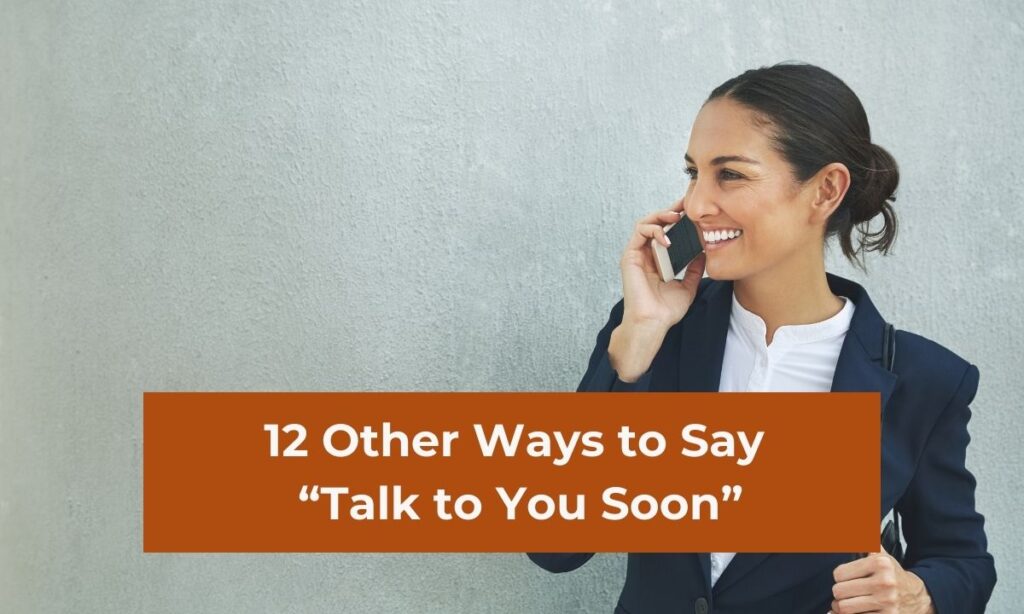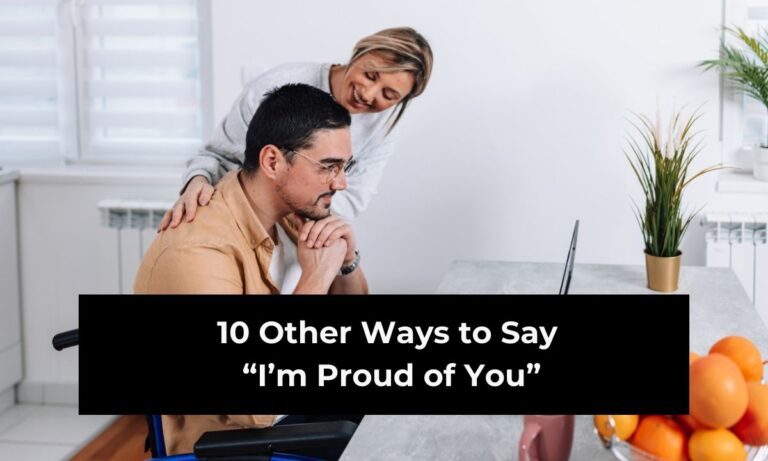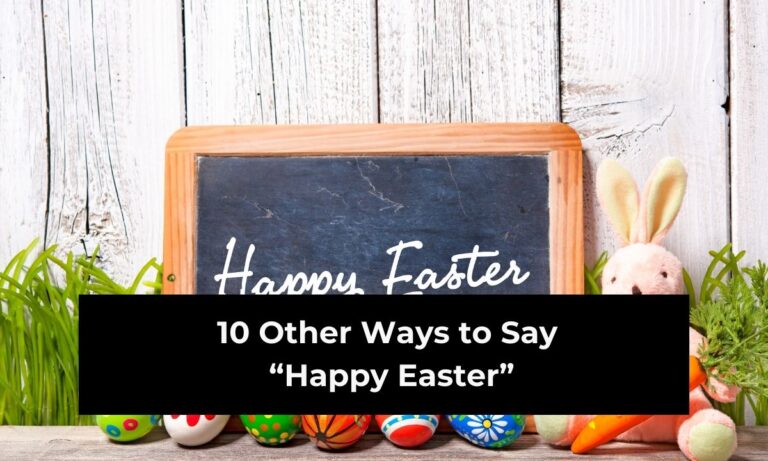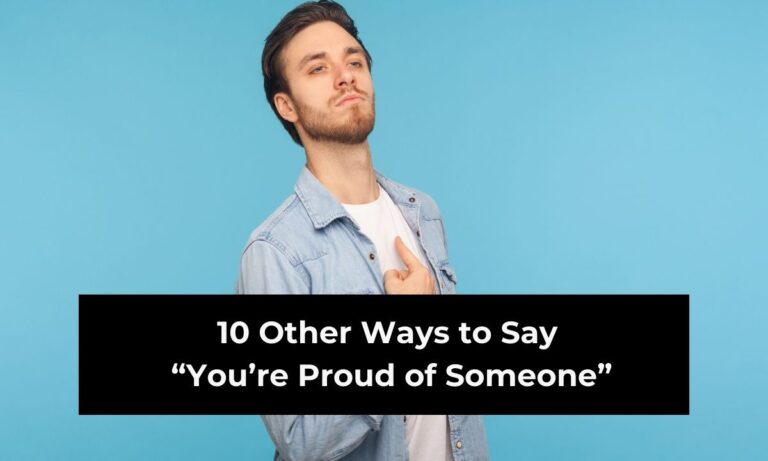You know that moment when you’re about to end a conversation—whether it’s over text, email, or a quick chat—and you don’t want to sound too repetitive?
That’s when “Talk to you soon” often slips out. It’s friendly, it’s safe, and it works… but if you use it all the time, it can start feeling a bit stale.
When you’re connecting with friends, family, colleagues, or clients, how you say goodbye leaves a lasting impression. Even a simple closing line can help you sound warmer, more genuine, or more professional—depending on the situation. The right choice can make your message stand out, show a little personality, and keep your communication fresh.

That’s why having a few creative alternatives to “Talk to you soon” up your sleeve can be a game-changer. Not only will it help you express yourself more clearly, but it can also strengthen relationships and make your conversations more memorable.
In this article, we’ll explore 12 different ways to say “Talk to you soon” that work in casual chats, friendly messages, and even professional settings. Each one will come with examples, context, and tips so you’ll know exactly when and how to use it.
Must Read:
- Other Ways to Say “Talk to You Then”
- Other Ways to Say “Stay Tuned”
- Other Ways to Say “Thinking of You”
By the end, you’ll have a collection of fresh, versatile phrases you can use whenever you want to switch things up—without losing the warmth and connection you’re aiming for.
1. Catch You Later
If you’re looking for a casual, friendly alternative to “Talk to you soon,” “Catch you later” is a perfect choice. It gives off a relaxed, approachable vibe that works well in both spoken and written conversations.
You can use it when texting friends, wrapping up a quick phone call, or even chatting with coworkers in a laid-back office environment. It’s not overly formal, which means it’s best for situations where you already have an easy rapport with the other person.
One of the great things about “Catch you later” is its flexibility. It doesn’t lock you into a specific time frame, so it works whether you expect to talk in an hour or in a few days. This open-ended nature can make your goodbye sound effortless and natural.
For example:
- After a friendly lunch with a colleague: “It was great catching up. Catch you later!”
- Wrapping up a casual text: “Alright, I’ve got to run. Catch you later.”
The phrase also has a slight playful undertone. It suggests that your paths will cross again naturally, almost like you’re leaving the door open for more conversation without forcing a commitment. That makes it ideal for relationships where you want to stay connected without pressure.
Just keep in mind that “Catch you later” might not be the best choice for very formal situations or when speaking with someone you don’t know well. In those cases, one of the more polished alternatives below might be a better fit.
2. Speak Soon
“Speak soon” is a short, simple alternative that keeps the warmth of “Talk to you soon” while sounding just a little fresher. It works especially well in text messages, emails, or quick notes when you want to keep things friendly but still leave the door open for more conversation in the near future.
This phrase has a slightly more intentional tone than casual options like “Catch you later.” It suggests that you expect another conversation will happen relatively soon, though it still leaves some flexibility on exactly when that will be.
For instance:
- Email to a teammate: “Thanks for the update. Speak soon!”
- Text to a friend: “I’ll send you those details tonight. Speak soon.”
Because it’s short and to the point, “Speak soon” works well in both personal and professional contexts. It’s friendly without being overly familiar, making it versatile for different relationships.
One tip: if you’re using it in a work-related email, you can pair it with a name to make it sound even warmer. For example: “Speak soon, Rachel.” This helps balance professionalism with approachability.
While it’s not as playful as some other phrases, “Speak soon” is a reliable go-to when you want to sound engaged, pleasant, and ready to continue the conversation soon.
3. Until Next Time
If you want to sound thoughtful and slightly more reflective, “Until next time” is a great choice. It carries a sense of anticipation and appreciation for the conversation you’ve just had, while also looking forward to the next one.
This phrase is particularly effective when wrapping up meaningful or memorable interactions. It works in spoken conversation, emails, or even handwritten notes.
For example:
- After meeting a friend for coffee: “It was so good catching up. Until next time.”
- Ending a professional meeting: “I appreciate your insights today. Until next time.”
“Until next time” feels timeless and warm. It’s less about when exactly you’ll speak again and more about the fact that you look forward to it whenever it happens. That makes it especially useful when you’re unsure of the exact timing of your next interaction.
It also works beautifully in creative or personal writing—like signing off a blog post, letter, or even a social media caption—where you want to leave your audience with a sense of connection.
If “Talk to you soon” feels too rushed for the tone you’re going for, “Until next time” adds a touch of grace and thoughtfulness that can make your goodbye more memorable.
4. See You Around
If you want to keep things light, breezy, and just a bit casual, “See you around” is an excellent choice. It’s often used in everyday conversation when there’s a good chance you’ll cross paths with someone again, even if you haven’t set a specific time.
This phrase works especially well in friendly settings—like chatting with neighbors, catching up with acquaintances, or talking to classmates. It carries a casual confidence that says, “We’ll bump into each other again.”
For example:
- Leaving a social gathering: “Great chatting with you. See you around!”
- Ending a casual workplace conversation: “Thanks for your help. See you around.”
One thing to keep in mind: “See you around” is more about in-person interactions than digital conversations. While you can use it in texts or emails, it feels most natural when you’re actually parting ways face-to-face.
It’s also a phrase that leans more toward casual friendliness than formality. If you’re ending a conversation with a client or in a formal work setting, you might want to opt for a more polished alternative from this list.
That said, when used in the right context, “See you around” is warm, approachable, and effortlessly friendly—perfect for keeping the connection open without committing to a set follow-up time.
5. Stay in Touch
“Stay in touch” is one of those versatile phrases that works beautifully in both personal and professional settings. It’s a little more intentional than “Talk to you soon” because it directly invites the other person to keep the conversation going.
This is a great option when you want to signal that you value the relationship and would like to hear from the other person again. It works particularly well when you’re parting ways for an extended period or when you’re not sure when the next conversation will happen.
For example:
- Email to a colleague after a conference: “It was great meeting you at the event. Let’s stay in touch.”
- Saying goodbye to a friend moving to a new city: “I’m going to miss you! Stay in touch.”
“Stay in touch” adds a layer of warmth and sincerity. It’s not just about when you will reach out—it’s also an invitation for the other person to reach out to you.
This phrase works well in networking situations too. It helps maintain connections without sounding pushy or overly formal. The key is to pair it with genuine interest so it doesn’t feel like a throwaway line.
If you’re aiming for something that bridges casual and professional, “Stay in touch” is a dependable and friendly option.
6. Chat Soon
“Chat soon” is a relaxed and friendly twist on “Talk to you soon.” It feels slightly more informal, making it a great choice for messages to friends, family, or close colleagues.
This phrase suggests that you expect the next conversation to be easygoing and possibly brief, which makes it perfect for casual catch-ups or quick updates.
For example:
- Texting a friend: “I’ll let you know when I’m free next week. Chat soon!”
- Wrapping up a casual email: “Thanks for the photos—made my day! Chat soon.”
Because “chat” feels lighter than “talk,” this phrase naturally gives off a warm, approachable vibe. It works well for digital communication like texts, instant messages, and informal emails.
It’s probably not the best choice for highly professional or formal situations—especially with clients or business partners you don’t know well—but it shines in everyday personal exchanges.
If “Talk to you soon” feels just a touch too formal for your situation, “Chat soon” is a friendly and easy swap that keeps the tone light and cheerful.
7. Keep Me Posted
“Keep me posted” is a great option when you want the other person to update you on something in the future. It’s more specific than “Talk to you soon” because it shows you’re interested in ongoing information.
It’s a versatile phrase that works in both professional and personal contexts, especially when there’s something in progress you want to hear more about.
For example:
- Work email: “Let me know how the project goes. Keep me posted.”
- Personal text: “Hope the move goes smoothly. Keep me posted.”
This phrase communicates engagement and genuine interest in what the other person is doing. It also puts the ball in their court to reach out when there’s news or updates.
In professional settings, it’s a polite and proactive way to encourage follow-up without sounding demanding. In personal contexts, it shows you care about their situation and want to be involved in their journey.
If you’re aiming for a sign-off that’s more about ongoing updates than a general goodbye, “Keep me posted” works beautifully.
8. Touch Base Soon
“Touch base soon” has a slightly more businesslike tone than many other alternatives on this list. It’s often used in professional contexts when you want to follow up, check in, or coordinate on something in the near future.
This phrase works well in emails, meetings, and work calls where you want to maintain a professional yet approachable tone.
For example:
- Email to a client: “I’ll review the documents and we can touch base soon.”
- Work call: “Let’s touch base soon to finalize the details.”
The term “touch base” implies a quick, purposeful interaction rather than a long conversation. It’s ideal for situations where the next communication will be more of a check-in than a full discussion.
Because it leans toward professional jargon, you probably wouldn’t use it often in casual conversations with friends. But in the workplace, it’s a useful and efficient way to close out a discussion while setting up the expectation of another one.
9. Looking Forward to Our Next Chat
If you want your sign-off to feel warm, personal, and optimistic, “Looking forward to our next chat” is a great option. It not only signals that you expect another conversation—it also shows genuine excitement for it.
This phrase works well in personal relationships, networking situations, and even some professional contexts where a friendly tone is appropriate.
For example:
- After meeting someone new at an event: “It was lovely talking to you. Looking forward to our next chat.”
- Wrapping up a call with a friend: “Always fun catching up. Looking forward to our next chat.”
It’s longer than most alternatives, which gives it a warmer and more expressive feel. It’s perfect when you want to make someone feel valued and appreciated.
If your goal is to end a conversation with genuine positivity, this phrase leaves people feeling good and looking forward to hearing from you again.
10. Talk Soonish
“Talk soonish” is playful, lighthearted, and great for informal exchanges. Adding “-ish” to the end makes it feel less rigid and more fun, as if you’re saying, “I’ll talk to you soon, but I’m not putting a hard deadline on it.”
This is perfect for texting friends or family when you want to sound casual and approachable.
For example:
- Text: “I’m off to run errands now. Talk soonish!”
- Message to a sibling: “We’ve got to catch up about that. Talk soonish.”
Because it’s quirky, it might not be the best choice in professional or formal settings. But in friendly conversations, it adds personality and charm to your goodbye.
11. Until We Speak Again
“Until we speak again” is a slightly poetic, heartfelt alternative that works well in both personal and professional contexts where you want to sound thoughtful.
It’s a little more formal than “Until next time,” making it suitable for meaningful interactions or situations where you want to leave a warm, lasting impression.
For example:
- Email to a mentor: “Thank you for your guidance. Until we speak again.”
- Closing a conversation with a long-distance friend: “Take care, until we speak again.”
It carries a sense of respect and anticipation, making it ideal for relationships where communication matters deeply.
12. Till Then
“Till then” is short, sweet, and flexible. It works well in both casual and semi-formal contexts when you want to wrap up a conversation without specifying exactly when you’ll talk again.
For example:
- Friend: “Can’t wait for the trip!” You: “Same here. Till then!”
- Work email: “I’ll have the final draft ready next week. Till then.”
It leaves the conversation open-ended, while still giving a sense of connection. The simplicity of “Till then” makes it easy to use and remember—perfect for quick sign-offs that still feel friendly.
Conclusion
“Talk to you soon” is a dependable phrase, but using it all the time can make your goodbyes sound predictable. By switching it up with alternatives like “Catch you later,” “Stay in touch,” or “Until we speak again,” you can keep your communication fresh, engaging, and perfectly suited to the context.
Each of the 12 alternatives in this list offers its own tone and personality—from the casual charm of “Talk soonish” to the professional polish of “Touch base soon.” The key is to match your choice to the situation and the relationship you have with the person you’re speaking to.
Adding variety to your sign-offs not only keeps conversations interesting but also helps you convey sincerity, warmth, and thoughtfulness. The next time you’re about to end a message, call, or email, pick a phrase that feels just right for the moment—and watch how it strengthens your connections over time.
FAQs
1. Can I use these phrases in professional emails?
Yes, many of these alternatives work in professional settings. Options like “Speak soon,” “Stay in touch,” and “Touch base soon” are great for work emails.
2. Which phrases are best for friends and family?
Casual, playful options like “Catch you later,” “Talk soonish,” and “Chat soon” work best for personal relationships.
3. How can I make a phrase sound warmer?
Adding the person’s name or a short personal note can make any sign-off feel warmer and more genuine.
4. Are there cultural differences in how these phrases are used?
Yes, some phrases may feel more common or natural in certain regions. For example, “See you around” is popular in casual American English, while “Till then” may feel more common in British English.
5. Should I always vary my sign-offs?
You don’t have to change them every time, but having a variety makes your communication feel more engaging and personal.





